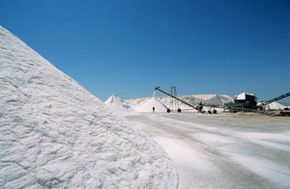Salt Mining
In 2006, more than 200 million tons of salt were produced in the world. China is the largest producer, with 48 million tons, followed closely by the United States, with 46 million tons [source: Salt Institute]. Salt is generally produced one of three ways: deep-shaft mining, solution mining or solar evaporation.
Deep-shaft mining is much like mining for any other mineral. Typically, the salt exists as deposits in ancient underground seabeds, which became buried through tectonic changes over thousands of years. Many salt mines use the "room and pillar" system of mining. Shafts are sunk down to the floor of the mine, and rooms are carefully constructed by drilling, cutting and blasting between the shafts, creating a checkerboard pattern. After the salt is removed and crushed, a conveyor belt hauls it to the surface. Most salt produced this way is used as rock salt.
Advertisement
In solution mining, wells are erected over salt beds or domes (deposits of salt forced up out of the earth by tectonic pressure) and water is injected to dissolve the salt. Then the salt solution, or brine, is pumped out and taken to a plant for evaporation. At the plant, the brine is treated to remove minerals and pumped into vacuum pans, sealed containers in which the brine is boiled and then evaporated until the salt is left behind. Then it is dried and refined. Depending on the type of salt it will be, iodine and an anti-clumping agent are added to the salt. Most table salt is produced this way.
When solution mines are located near chemical plants, they are called brine wells, and the salt is used for chemical production. After the salt is removed from a salt mine, the empty room often stores other substances, like natural gas or industrial wastes.
Salt is harvested through solar evaporation from seawater or salt lakes. Wind and the sun evaporate the water from shallow pools, leaving the salt behind. It is usually harvested once a year when the salt reaches a specific thickness. After harvest, the salt is washed, drained, cleaned and refined. This is the purest way to harvest salt, often resulting in nearly 100 percent sodium chloride. Only areas with low annual rainfall and high evaporation rates -- Mediterranean countries and Australia, for example -- can have successful solar evaporation plants. Usually machines perform this harvest, but in some areas it is still done by hand.
Next, we'll look at the history of salt and learn about some of its cultural significance.
